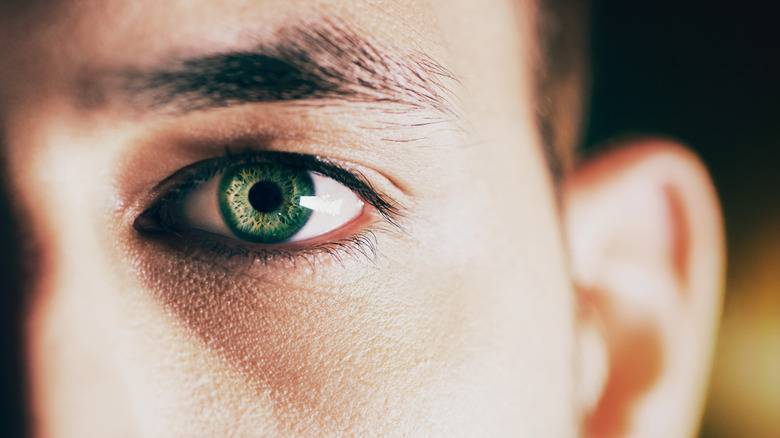The Big Advantage To Having Green Eyes
One of the more interesting things about humans is the color of their eyes. A variation in your genes is what determines whether you end up with amber, blue, brown, gray, green, hazel, or red eyes.
But if you've ever known someone with green eyes or are blessed with this hue, you probably already know that it is the rarest shade in the world when it comes to eye color. In fact, only 2% of the world population has them (via Medical News Today). And, like anything rare in this world, it is usually considered attractive. In fact, it's the eye color people find most attractive, with 20.3 % of people voting for it in a 2022 survey (via My Vision). Lucky you and celebrities like Adele, Kate Middleton, Scarlett Johansson, Charlize Theron, Paul Rudd, and Channing Tatum!
However, it turns out that having green eyes might also provide a big advantage when it comes to your health. People with green peepers may be able to tolerate pain better, at least according to a 2014 study published in The Journal of Pain.
Green eyes have been linked to greater pain tolerance
Fifty-eight healthy pregnant women from Magee-Womens Hospital of the University of Pittsburgh Medical Center (UPMC) were chosen for the study and their pain was assessed before and after childbirth, per UPMC. Among the subjects, 24 of the women had brown or hazel eyes and 34 had green or blue. Researchers found that the subjects with lighter hues — blue and green — experienced significantly less discomfort before and after childbirth when compared with their darker-eyed counterparts. Commenting on the study, associate professor of anesthesiology at the University of Pittsburgh Inna Belfer shared, "There have been previous studies about the relationship of gender, age, and hair color to pain, but this is the first research on eye color." Belfer further noted that this type of work can have important implications in understanding how a person's genetic makeup can influence pain and pain relief. The study, however, was small and involved only white women.
On the flip side of the 2014 study was a 2017 study found in the journal Somatosensory and Motor Research which found an association between dark hair and eyes and greater sensitivity to pain. This study took 60 healthy individuals and divided them into groups of 15 based on eye and hair color and gender. The study participants then had their pressure pain thresholds, cold pressor test, and the quality of their perceived pain assessed. Those with dark pigmentation were found to be most sensitive to the cold pressor test.
It's unclear, however, just how strong the link is between green eyes and pain tolerance. The 2014 study was a pilot study involving only a small number of women and more research is needed to confirm what it might mean. In fact, a 2018 study published in the Journal of Endodontics which looked at eye color and dental injection pain found no significant correlation between green eyes and high pain tolerance. So if you have green eyes, maybe you shouldn't go boasting about that theory (or putting it to the test) just yet.
Green eyes may have some disadvantages as well
As for eye health and green eyes, you may want to know that it's not all advantages with this hue either. Lighter-shaded eyes are more sensitive to light, according to an ophthalmologist at Virginia Eye Consultants in Norfolk, Virginia, Dr. Usiwoma Abugo (via Everyday Health). The science is pretty straightforward — more melanin means more protection from the sun's UV rays and less means less protection, as is the case with green and blue eyes. "The lack of pigment is also what can make those eyes potentially more sensitive to light," explained the ophthalmologist. People with less melanin in their eyes might also be more prone to certain cancers, like uveal melanoma, per a 2020 study published in the International Journal of Molecular Sciences.
Green eyes or not, be mindful of wearing sunglasses and general eye health. UCLA Health advises looking for sunglasses that offer 100% UV protection from all UV light (UVA and UVB) or 100% protection against UV 400. They also suggest that oversized or wraparound sunglasses will offer the best protection. Aetna states that regular eye exams are also important, even if you don't have any vision problems. Getting an exam every five years is sufficient for younger people up to age 39. However, more frequent exams are better as you grow older. For example, adults age 65 and older will want to have a checkup every one to two years.



